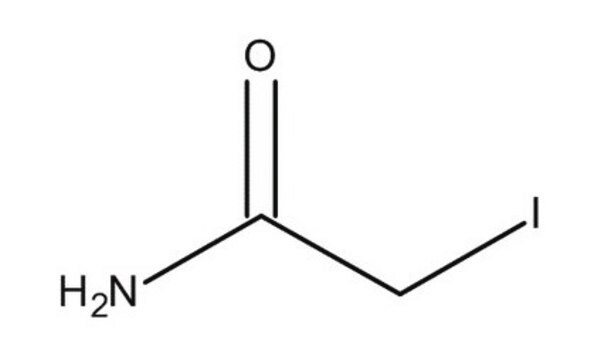모든 사진(5)
About This Item
Linear Formula:
ICH2CONH2
CAS Number:
Molecular Weight:
184.96
Beilstein:
1739080
EC Number:
MDL number:
UNSPSC 코드:
12352202
PubChem Substance ID:
NACRES:
NA.77
추천 제품
애플리케이션
- A Mass Spectrometry Strategy for Protein Quantification Based on the Differential Alkylation of Cysteines Using Iodoacetamide and Acrylamide.: This study presents a novel mass spectrometry method for quantifying proteins by differentially alkylating cysteines with iodoacetamide and acrylamide, enhancing the accuracy of protein quantification in complex samples. (Virág et al., 2024).
- Laminarin ameliorates iodoacetamide-induced functional dyspepsia via modulation of 5-HT(3) receptors and the gut microbiota.: Research demonstrates that laminarin can mitigate functional dyspepsia induced by iodoacetamide through modulating 5-HT(3) receptors and altering gut microbiota composition, offering potential therapeutic benefits. (Liu et al., 2024).
- Redox proteomics in melanoma cells: An optimized protocol.: This paper describes an optimized redox proteomics protocol using iodoacetamide, which facilitates the identification of redox-sensitive proteins in melanoma cells, aiding in the understanding of redox regulation in cancer. (Cunha et al., 2024).
- Molecular targets of cisplatin in HeLa cells explored through competitive activity-based protein profiling strategy.: Utilizing iodoacetamide in competitive activity-based protein profiling, this study identifies molecular targets of cisplatin in HeLa cells, providing insights into the drug′s mechanisms. (Chen et al., 2024).
- Development and Comparison of 4-Thiouridine to Cytidine Base Conversion Reaction.: This research compares base conversion reactions involving 4-thiouridine and cytidine, with iodoacetamide playing a crucial role in the reaction mechanism, contributing to advancements in nucleotide chemistry. (Ohashi et al., 2024).
생화학적/생리학적 작용
Iodoacetamide acts as an alkylating reagent for cysteine residues in peptide sequencing. It is an irreversible inhibitor of enzymes with cysteine at the active site. It reacts much more slowly with histidine residues, but that activity is responsible for inhibiting ribonuclease.
신호어
Danger
유해 및 위험 성명서
Hazard Classifications
Acute Tox. 3 Oral - Aquatic Chronic 4 - Resp. Sens. 1 - Skin Sens. 1
Storage Class Code
6.1C - Combustible acute toxic Cat.3 / toxic compounds or compounds which causing chronic effects
WGK
WGK 3
Flash Point (°F)
Not applicable
Flash Point (°C)
Not applicable
개인 보호 장비
Eyeshields, Faceshields, Gloves, type P2 (EN 143) respirator cartridges
이미 열람한 고객
Mirko Zaffagnini et al.
Antioxidants & redox signaling, 16(1), 17-32 (2011-06-29)
Cysteines (Cys) made acidic by the protein environment are generally sensitive to pro-oxidant molecules. Glutathionylation is a post-translational modification that can occur by spontaneous reaction of reduced glutathione (GSH) with oxidized Cys as sulfenic acids (-SOH). The reverse reaction (deglutathionylation)
Chiara Francavilla et al.
The Journal of cell biology, 187(7), 1101-1116 (2009-12-30)
Neural cell adhesion molecule (NCAM) associates with fibroblast growth factor (FGF) receptor-1 (FGFR1). However, the biological significance of this interaction remains largely elusive. In this study, we show that NCAM induces a specific, FGFR1-mediated cellular response that is remarkably different
Helen R Stagg et al.
The Journal of cell biology, 186(5), 685-692 (2009-09-02)
The US2 and US11 gene products of human cytomegalovirus promote viral evasion by hijacking the endoplasmic reticulum (ER)-associated degradation (ERAD) pathway. US2 and US11 initiate dislocation of newly translocated major histocompatibility complex class I (MHC I) from the ER to
Valentina R Minciacchi et al.
Oncotarget, 6(13), 11327-11341 (2015-04-11)
Large oncosomes (LO) are atypically large (1-10 µm diameter) cancer-derived extracellular vesicles (EVs), originating from the shedding of membrane blebs and associated with advanced disease. We report that 25% of the proteins, identified by a quantitative proteomics analysis, are differentially
Gabriela Venturini et al.
American journal of physiology. Cell physiology, 317(2), C326-C338 (2019-05-09)
Atherosclerotic plaque development is closely associated with the hemodynamic forces applied to endothelial cells (ECs). Among these, shear stress (SS) plays a key role in disease development since changes in flow intensity and direction could stimulate an atheroprone or atheroprotective
자사의 과학자팀은 생명 과학, 재료 과학, 화학 합성, 크로마토그래피, 분석 및 기타 많은 영역을 포함한 모든 과학 분야에 경험이 있습니다..
고객지원팀으로 연락바랍니다.




